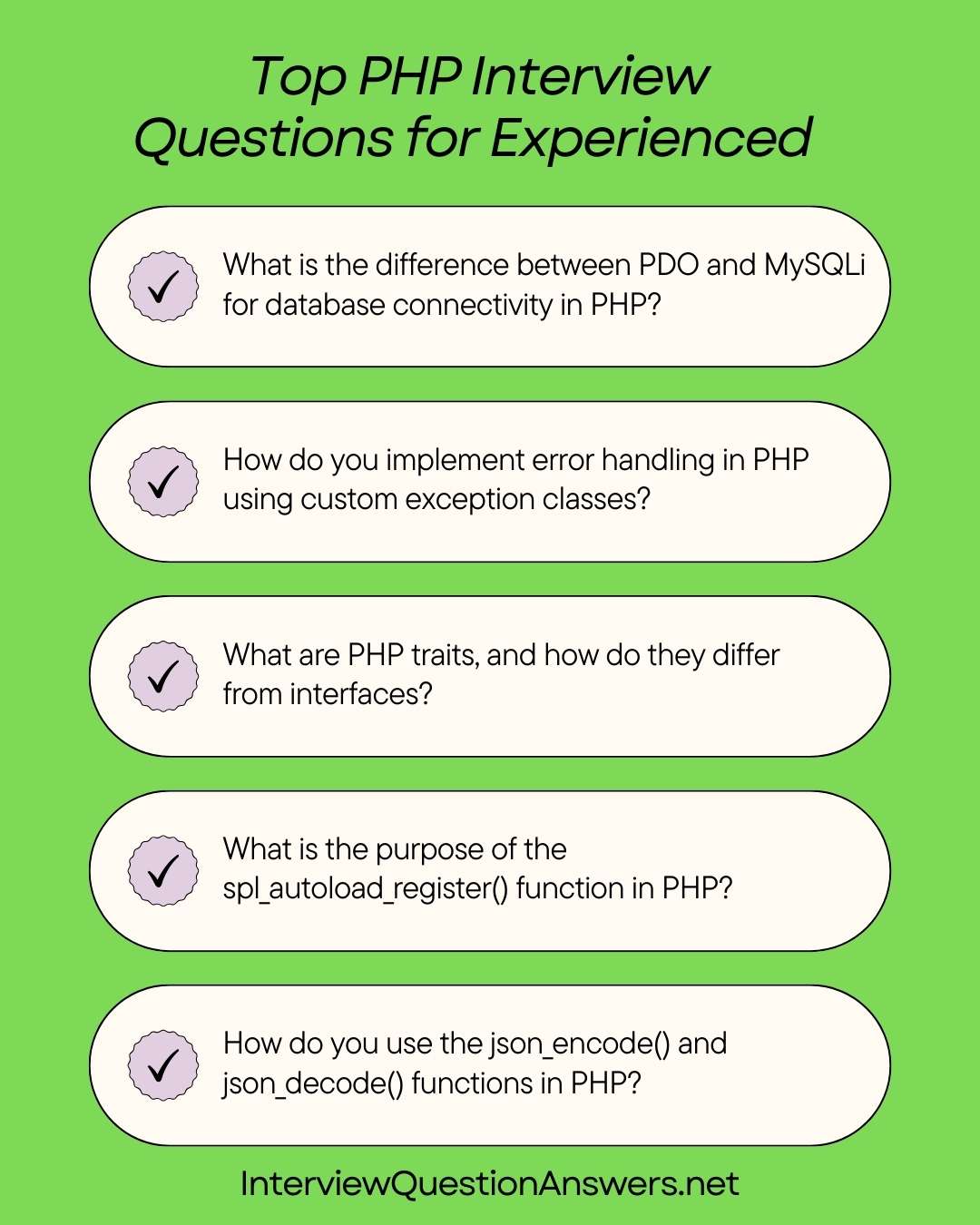Most Asked PHP Interview Questions for Experienced 2025
This PHP Interview Questions list is pure gold for experienced PHP devs who wanna smash their next job interview. It’s packed with the toughest and most common questions that big companies throw at senior candidates, with stuff like advanced PHP concepts, OOP, security, performance tuning, and real-world problem-solving.
You’ll find deep dives into PHP frameworks (Laravel, Symfony, etc.), database optimization, API integrations, and best practices that only pros need to know. Every question comes with clear answers and practical examples so you can explain smoothly. Plus, it covers tricky scenarios, debugging tips, and industry-level mistakes that even experienced devs sometimes mess up.
We also have an in-depth php interview guide, you can check it here: PHP Interview Questions and Answers PDF
Table of Contents
PHP Interview Questions for 2 Years Experience
Que 1. How does PHP handle sessions, and what are the key considerations for session security?
Answer: PHP handles sessions using session_start() to initiate a session, storing data in $_SESSION. Sessions are maintained via a session ID, typically stored in a cookie. For security, regenerate session IDs with session_regenerate_id() to prevent fixation attacks, use HTTPS to encrypt data, set session.cookie_secure in php.ini, and store session data securely (e.g., in a database instead of files).
Que 2. What is the difference between PDO and MySQLi for database connectivity in PHP?
Answer:
| Feature | PDO | MySQLi |
|---|---|---|
| Database Support | Multiple databases (MySQL, PostgreSQL, etc.) | MySQL only |
| API | Object-oriented, procedural | Object-oriented, procedural |
| Prepared Statements | Supported | Supported |
| Error Handling | Exception-based | Mixed (exceptions, errors) |
Example:
$pdo = new PDO("mysql:host=localhost;dbname=test", "user", "pass");
$stmt = $pdo->prepare("SELECT * FROM users WHERE id = ?");Que 3. How do you implement error handling in PHP using custom exception classes?
Answer: Custom exception classes extend Exception to handle specific errors, using try-catch blocks for control.
Example:
class CustomException extends Exception {}
try {
throw new CustomException("Custom error");
} catch (CustomException $e) {
echo $e->getMessage();
}Que 4. What is the role of the .htaccess file in PHP applications?
Answer: The .htaccess file configures Apache server settings, such as URL rewriting, access control, and custom error pages. In PHP, it’s used to redirect requests, secure directories, or set PHP configurations (e.g., php_value upload_max_filesize 10M).
Que 5. How do you use the filter_var() function in PHP for input validation?
Answer: The filter_var() function validates or sanitizes input using predefined filters, like FILTER_VALIDATE_EMAIL or FILTER_SANITIZE_STRING.
Example:
$email = "test@example.com";
if (filter_var($email, FILTER_VALIDATE_EMAIL)) {
echo "Valid email";
}Que 6. What are PHP traits, and how do they differ from interfaces?
Answer: Traits provide reusable methods for classes, included with use, while interfaces define method signatures without implementation.
Example:
trait Loggable {
public function log($msg) {
echo $msg;
}
}
class User {
use Loggable;
}Que 7. How do you optimize PHP code for performance?
Answer: Optimize PHP by using efficient loops, caching (e.g., OPCache), minimizing database queries, and using unset() for memory management. Avoid unnecessary includes, use prepared statements, and leverage array functions like array_map().
Que 8. What is the purpose of the spl_autoload_register() function in PHP?
Answer: The spl_autoload_register() function registers a function to autoload classes when instantiated, eliminating manual require.
Example:
spl_autoload_register(function ($class) {
require "classes/$class.php";
});Que 9. How do you handle file uploads securely in PHP?
Answer: Secure file uploads by validating file type, size, and extension using $_FILES, checking is_uploaded_file(), and using move_uploaded_file(). Restrict upload directories and sanitize filenames to prevent attacks.
Example:
if (is_uploaded_file($_FILES['file']['tmp_name'])) {
move_uploaded_file($_FILES['file']['tmp_name'], "uploads/" . basename($_FILES['file']['name']));
}PHP Interview Questions for 3 Years Experience
Que 10. What is the difference between abstract classes and interfaces in PHP?
Answer:
| Feature | Abstract Class | Interface |
|---|---|---|
| Implementation | Can have partial implementation | No implementation |
| Inheritance | Single inheritance | Multiple interfaces |
| Access Modifiers | Supports public, private, etc. | Public only |
Example:
interface Printable {
public function print();
}Que 11. How do you use the array_reduce() function in PHP?
Answer: The array_reduce() function reduces an array to a single value using a callback function.
Example:
$array = [1, 2, 3];
$sum = array_reduce($array, fn($carry, $item) => $carry + $item, 0);
echo $sum; // Outputs: 6Que 12. What is the purpose of the setcookie() function in PHP?
Answer: The setcookie() function sends a cookie to the client’s browser, specifying name, value, expiration, and other parameters.
Example:
setcookie("user", "Alice", time() + 3600);Que 13. How do you use PHP’s magic methods like __construct() and __destruct()?
Answer: Magic methods like __construct() initialize objects, and __destruct() cleans up resources when objects are destroyed.
Example:
class MyClass {
public function __construct() {
echo "Object created";
}
public function __destruct() {
echo "Object destroyed";
}
}Que 14. What is the purpose of the http_response_code() function in PHP?
Answer: The http_response_code() function sets or gets the HTTP status code for the current response.
Example:
http_response_code(404);
echo "Not Found";Que 15. How do you use the json_encode() and json_decode() functions in PHP?
Answer: json_encode() converts a PHP value to a JSON string, and json_decode() converts a JSON string to a PHP value.
Example:
$data = ["name" => "Alice"];
$json = json_encode($data);
echo json_decode($json, true)['name']; // Outputs: Alice
Que 16. What is the role of the final keyword in PHP?
Answer: The final keyword prevents a class from being extended or a method from being overridden.
Example:
final class MyClass {
final public function myMethod() {}
}Que 17. How do you implement form validation in PHP?
Answer: Validate form data using filter_var(), empty(), and custom checks, ensuring required fields, formats, and sanitization.
Example:
if (empty($_POST['name']) || !filter_var($_POST['email'], FILTER_VALIDATE_EMAIL)) {
echo "Invalid input";
}Que 18. What is the difference between static and instance methods in PHP?
Answer: Static methods belong to the class, called with ::, while instance methods belong to an object, called with ->.
Example:
class MyClass {
public static function staticMethod() {
echo "Static";
}
}
MyClass::staticMethod(); // Outputs: StaticQue 19. How do you use the password_hash() and password_verify() functions in PHP?
Answer: password_hash() creates a secure hash, and password_verify() checks a password against a hash.
Example:
$hash = password_hash("mypassword", PASSWORD_DEFAULT);
if (password_verify("mypassword", $hash)) {
echo "Valid";Que 20. What is the purpose of the ob_start() and ob_end_flush() functions in PHP?
Answer: ob_start() enables output buffering, capturing output until ob_end_flush() sends it to the browser, useful for headers or content manipulation.
Example:
ob_start();
echo "Buffered";
ob_end_flush();
PHP Interview Questions for 5 Years Experience
Que 21. How do you implement a custom autoloader in PHP following PSR-4 standards?
Answer: A PSR-4 autoloader maps namespaces to directories, using spl_autoload_register() to load classes dynamically. Define the namespace-to-path mapping in composer.json or a custom autoloader function.
Example:
spl_autoload_register(function ($class) {
$prefix = 'App\\';
$baseDir = __DIR__ . '/src/';
$len = strlen($prefix);
if (strncmp($prefix, $class, $len) !== 0) {
return;
}
$file = $baseDir . str_replace('\\', '/', substr($class, $len)) . '.php';
if (file_exists($file)) {
require $file;
}
});Que 22. What is the role of PHP’s opcache, and how do you configure it for optimal performance?
Answer: OPcache improves PHP performance by caching compiled bytecode, reducing parsing overhead. Configure in php.ini with settings like opcache.enable=1, opcache.memory_consumption=128, and opcache.max_accelerated_files=10000.
Que 23. How do you handle database transactions in PHP using PDO?
Answer: PDO handles transactions with beginTransaction(), commit(), and rollBack() to ensure atomicity.
Example:
$pdo = new PDO("mysql:host=localhost;dbname=test", "user", "pass");
$pdo->beginTransaction();
try {
$pdo->exec("INSERT INTO users (name) VALUES ('Alice')");
$pdo->commit();
} catch (Exception $e) {
$pdo->rollBack();
echo "Transaction failed: " . $e->getMessage();
}Que 24. What are PHP’s attribute annotations, and how are they used in modern PHP applications?
Answer: Introduced in PHP 8, attributes provide metadata for classes, methods, or properties, replacing docblock annotations. They’re used in frameworks like Symfony for routing or validation.
Example:
#[Route('/home')]
class HomeController {
public function index() {
return "Home";
}
}Que 25. How do you implement a queue system in PHP for background processing?
Answer: Implement a queue system using libraries like Pheanstalk (Beanstalkd) or Laravel’s queue system with Redis/database backends. Define jobs, dispatch with a queue driver, and process with workers.
Example:
use Pheanstalk\Pheanstalk;
$pheanstalk = Pheanstalk::create('127.0.0.1');
$pheanstalk->useTube('myqueue')->put(json_encode(['task' => 'process']));Que 26. How do you implement dependency injection in PHP, and what are its benefits?
Answer: Dependency injection (DI) in PHP involves passing dependencies (objects or services) to a class, typically via constructor or setter methods, rather than creating them internally. This promotes loose coupling and testability. Use a DI container like PHP-DI or Laravel’s service container to manage dependencies automatically.
Example:
class UserService {
private $db;
public function __construct(Database $db) {
$this->db = $db;
}
}Que 27. What is the role of Composer in PHP, and how do you manage dependencies with it?
Answer: Composer is a dependency manager for PHP, handling package installation, autoloading, and version management. Define dependencies in composer.json, and run composer install or composer update. Autoloading is configured via autoload section or PSR-4 standards.
Example:
{
"require": {
"monolog/monolog": "^2.0"
},
"autoload": {
"psr-4": {
"App\\": "src/"
}
}
}Que 28. How do you secure a PHP REST API against common vulnerabilities?
Answer: Secure a PHP REST API by:
- Using HTTPS for encryption.
- Implementing OAuth2 or JWT for authentication.
- Validating and sanitizing inputs with
filter_var(). - Using prepared statements to prevent SQL injection.
- Setting CORS headers and CSRF tokens.
- Rate-limiting with middleware (e.g., in Laravel).
Que 29. What are PHP’s PSR standards, and which ones are commonly used?
Answer: PSR (PHP Standards Recommendations) are coding standards by the PHP-FIG for interoperability. Common ones include:
- PSR-4: Autoloading standard.
- PSR-7: HTTP message interfaces.
- PSR-12: Coding style guide.
PHP Interview Questions for 7 Years Experience
Que 30. How do you optimize database queries in PHP applications?
Answer: Optimize queries by:
- Using indexes on frequently queried columns.
- Employing prepared statements for efficiency.
- Caching results with Memcached or Redis.
- Avoiding
SELECT *and fetching only needed columns. - Using EXPLAIN to analyze query performance.
Que 31. What is the purpose of PHP’s Reflection API, and how is it used?
Answer: The Reflection API inspects and interacts with classes, methods, and properties at runtime, useful for debugging or dynamic frameworks.
Example:
$reflection = new ReflectionClass('MyClass');
echo $reflection->getName(); // Outputs: MyClassQue 32. How do you implement caching in PHP to improve performance?
Answer: Implement caching using APCu, Memcached, or Redis for data, and OPCache for bytecode. Use apcu_store() or Redis::set() for key-value caching, and configure opcache.enable=1 in php.ini.
Example:
$redis = new Redis();
$redis->connect('127.0.0.1');
$redis->setex('key', 3600, 'value');Que 33. What is the difference between early and late binding in PHP?
Answer:
| Feature | Early Binding | Late Binding |
|---|---|---|
| Resolution Time | Compile-time | Runtime |
| Example | self::method() | static::method() |
| Use Case | Fixed class behavior | Dynamic class behavior |
Example:
class ParentClass {
public static function who() {
echo static::class;
}
}
class ChildClass extends ParentClass {}
ChildClass::who(); // Outputs: ChildClass (late binding)Que 34. How do you handle large file processing in PHP without memory issues?
Answer: Process large files using SplFileObject for line-by-line reading, fopen() with fread() for chunks, or stream_get_line(). Avoid loading entire files with file_get_contents().
Example:
$file = new SplFileObject('large.txt');
while (!$file->eof()) {
echo $file->fgets();
}Que 35. What are PHP generators, and how do they improve performance?
Answer: Generators use yield to produce values iteratively, avoiding loading entire datasets into memory. They’re ideal for processing large datasets or streams.
Example:
function generateNumbers() {
for ($i = 0; $i < 1000; $i++) {
yield $i;
}
}
foreach (generateNumbers() as $num) {
echo $num;
}Que 36. How do you use PHP’s DateTime class for date manipulation?
Answer: The DateTime class handles date/time operations, supporting formatting, timezones, and calculations.
Example:
$date = new DateTime('2025-08-14');
$date->modify('+1 day');
echo $date->format('Y-m-d'); // Outputs: 2025-08-15Que 37. What is the role of middleware in PHP frameworks like Laravel?
Answer: Middleware in PHP frameworks like Laravel processes HTTP requests before reaching controllers or after responses, handling tasks like authentication, logging, or input validation.
Example:
class AuthMiddleware {
public function handle($request, Closure $next) {
if (!isset($_SESSION['user'])) {
header('Location: /login');
exit;
}
return $next($request);
}
}Que 38. How do you implement unit testing in PHP using PHPUnit?
Answer: PHPUnit is used for unit testing by creating test classes extending PHPUnit\Framework\TestCase, with methods prefixed by test.
Example:
class MyTest extends PHPUnit\Framework\TestCase {
public function testAddition() {
$this->assertEquals(4, 2 + 2);
}
}Que 39. What is the purpose of PHP’s anonymous classes, and when are they useful?
Answer: Anonymous classes, introduced in PHP 7, are unnamed classes used for one-off objects, often in testing or quick implementations.
Example:
$object = new class {
public function say() {
return "Hello";
}
};
echo $object->say(); // Outputs: HelloQue 40. How do you handle CSRF protection in PHP applications?
Answer: Implement CSRF protection by generating and validating tokens in forms, storing them in sessions, and checking on submission. Frameworks like Laravel automate this.
Example:
session_start();
$_SESSION['csrf_token'] = bin2hex(random_bytes(32));
PHP Interview Questions for 10 Years Experience
Que 41. What is the difference between session and cookie storage in PHP?
Answer:
| Feature | Session | Cookie |
|---|---|---|
| Storage | Server-side | Client-side |
| Security | More secure | Less secure |
| Lifetime | Until session ends | Set by expiration |
Que 42. How do you use PHP’s SimpleXML for parsing XML data?
Answer: SimpleXML parses XML into an object, allowing easy access to elements and attributes.
Example:
$xml = simplexml_load_string('<user><name>Alice</name></user>');
echo $xml->name; // Outputs: AliceQue 43. What is the purpose of PHP’s filter_input() function?
Answer: The filter_input() function retrieves and filters external input (e.g., $_GET, $_POST) securely.
Example:
$email = filter_input(INPUT_POST, 'email', FILTER_VALIDATE_EMAIL);Que 44. How do you implement rate limiting in a PHP application?
Answer: Rate limiting restricts API or page access using middleware or libraries like ratelimiter. Store request counts in Redis or sessions with timestamps.
Example:
$redis = new Redis();
if ($redis->incr('user:requests') > 100) {
http_response_code(429);
}Que 45. What is the role of PHP’s SplFixedArray, and when is it used?
Answer: SplFixedArray is a fixed-size array with better performance than regular arrays for known sizes, used in performance-critical applications.
Example:
$array = new SplFixedArray(3);
$array[0] = 1;Que 46. How do you handle file downloads in PHP securely?
Answer: For secure file downloads, use header() to set content type and disposition, validate file paths, and read files with readfile().
Example:
$file = 'files/doc.pdf';
header('Content-Type: application/pdf');
header('Content-Disposition: attachment; filename="' . basename($file) . '"');
readfile($file);Que 47. What is PHP’s Guzzle library, and how is it used for HTTP requests?
Answer: Guzzle is a PHP HTTP client for making requests to APIs, supporting GET, POST, and async requests.
Example:
use GuzzleHttp\Client;
$client = new Client();
$response = $client->get('https://api.example.com');Que 48. How do you implement logging in PHP for production applications?
Answer: Use Monolog for logging, configuring handlers for files, databases, or external services like Slack. Set log levels for debugging or errors. For 5-10 years, structured logging with context is critical.
Example:
use Monolog\Logger;
use Monolog\Handler\StreamHandler;
$log = new Logger('app');
$log->pushHandler(new StreamHandler('app.log'));
$log->info('User logged in');
Que 49. What is the purpose of PHP’s password_hash() options, and how do you tune them?
Answer: password_hash() options like cost control computational complexity for bcrypt. Higher costs increase security but slow performance. Tune based on server capacity.
Example:
$hash = password_hash('mypassword', PASSWORD_BCRYPT, ['cost' => 12]);Que 50. How do you use PHP’s streams for advanced file handling?
Answer: PHP streams provide a uniform interface for file and network operations, using wrappers like file:// or http://. Use stream_context_create() for custom settings.
Example:
$context = stream_context_create(['http' => ['method' => 'GET']]);
$content = file_get_contents('http://example.com', false, $context);












